
The Moov HR builds on the foundation of the startup’s previous sensor, the Moov Now, which garnered praise for its innovative approach to fitness. Rather than simply measuring the number of steps you’ve taken, the calories you’ve burned, and distance you’ve walked, it fed that data into an artificial intelligence that dynamically guided you through goal-oriented workouts. Cycling too leisurely to burn a certain number of calories? A robotic voice pushed you to pick up the pace. Fall half a mile short of your average jogging distance? Moov’s AI provided words of encouragement.

The Moov notably omitted a means of tracking heart rate, though. The obvious solution was to introduce a follow-up with a built-in heart sensor, but Moov’s three founders, Nikola Hu, Tony Yuan, and Meng Li, wanted a solution that wouldn’t be susceptible to the same biological interference as wrist-bound models. “There are so many heart rate monitors on the market, but many are very inaccurate,” Hu said, and that’s no exaggeration. A recent study by researchers at the Cleveland Clinic’s Heart and Vascular Institute found that some of the most popular fitness trackers reported measurements off by as much as 40 beats per minute. “It’s very dangerous to [base workouts] on the wrong data,” Hu said.
So the Moov team took a different tack. Rather than work within the confines of wrist-bound fitness trackers, the startup’s engineers went for the head — the forehead, to be exact. The reasoning came down to physiology. “Green light” sensors, the technology by which most activity trackers measure heart rate, measure heart rate by penetrating the upper layers of skin with visible light. It’s a principle known as phyotoplethysmography (PPG): Because blood is red and absorbs green light, the sensors are able to gauge the flow of blood through veins. Between heart beats, there’s less absorption of green light, and during heart beats, there’s more.

What’s that got to do with headbands? Layers of skin around the temple area of the head are far thinner than those around the wrist, Yuan explained. “The wrist is not one of the best places to measure [heart rate]. There are many complex structures [and] tissues there,” he said. “It’s difficult to measure accurately [and] you have to guess.” The forehead, by comparison, has far better blood profusion — the ease with which heart pumps blood through capillaries. “The blood profusion changes over time [are] very clear,” Yuan said.
The team contends that the Moov HR’s can measure heart rate far more accurately most fitness trackers, and in a demo of the tech via Skype, that certainly appeared to be the case. Yuan performed a series of squats while wearing both the Moov HR and a Fitbit tracker, and both showed his heart rate climbing. After a minute, the Moov HR reported a reading not only a reading higher than the Fitbit, but significantly closer to Yuan’s historical, EKG-recorded heart rate: At one point, 118 beats per minute versus the Fitbit’s 78.

Sensor placement was only one piece of the overall puzzle, though. Software was another: Yuan said the team tuned the Moov HR’s heart rate measurements specifically to the forehead’s thinner skin surface. “The software and algorithm is optimized for this location,” Yuan said. “It’s optimized specifically for heart rate.” And the Moov’s companion smartphone app has been redesigned to match: It records the wearable’s heart rate in real time, on a bar graph.
There’s more to the new app than meets the eye. Moov’s developed new AI-guided workout sessions — “intensity-based coaching and target zones,” it calls them — around the headband’s heart rate measuring capabilities. Begin a cardio session and an onscreen, animated figure will guide you through a series of timed workouts, during which your current heart rate will display in the top-left corner of the screen. If your heart rate drops below the optimal range for your specified age, height, and weight, a virtual fitness coach will verbally prompt you to up the intensity. You might be told to raise your heart rate by seven percent for the duration of the session, for instance, or target a higher heart rate before the next routine begins. At the end of each workout, your heart rate’s charted on a graph.

The Moov team couches the mission in motivational terms. “Basically, we don’t just want to deliver technology,” Nikola said. “We want to get people in shape.” She points to a 2016 study by Clarkson University that showed that typically, fitness monitors didn’t meaningfully impact wearers’ activity levels. “Our approach is different. We want to help people get in shape by [giving] actionable guidance and coaching.”
The Moov HR is launching in two models: the Moov Sweat, which ships with an elastic headband; and the Moov Swim, which comes with a swim cap. Both are available for the pre-order price of $60, and can be purchased together for $100. Both will increase in price when they retail early next year.
The Moov HR is compatible with the Moov Now, Nikola said, but the startup isn’t bundling the two just yet. “People can add both to their shopping cart,” she said. “It’s definitely something we want to communicate — the benefit of having a comprehensive [solution].”
Editors' Recommendations
- I wore the Whoop 4.0 fitness tracker for a month. Here’s why I’m getting rid of it
- Samsung’s new fitness tracker could be released any day now
- Subscriptions are quickly ruining fitness trackers
- Whoop 4.0 vs. Oura: Which screenless health tracker should you wear?
- You shouldn’t need an accountant to buy a new fitness tracker


